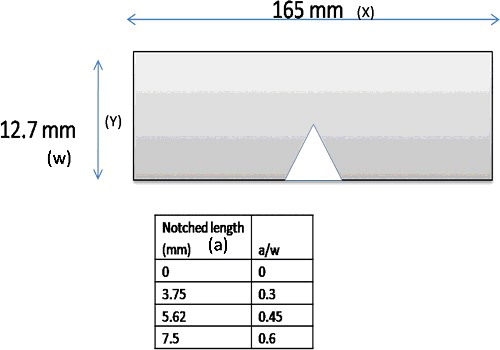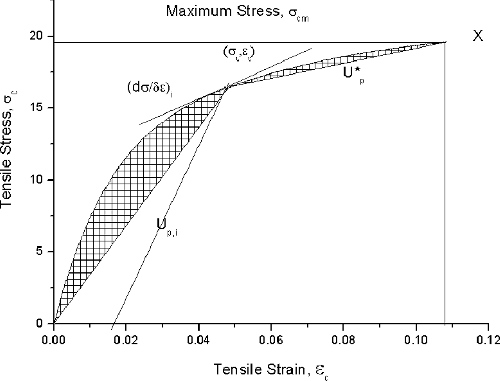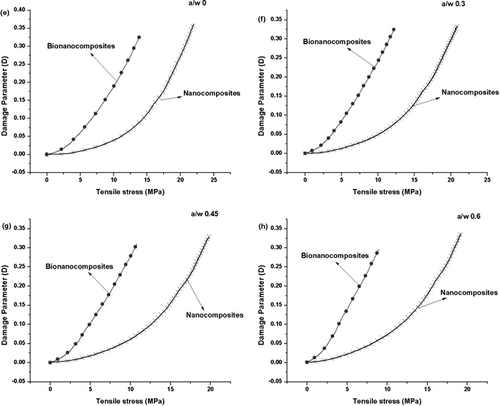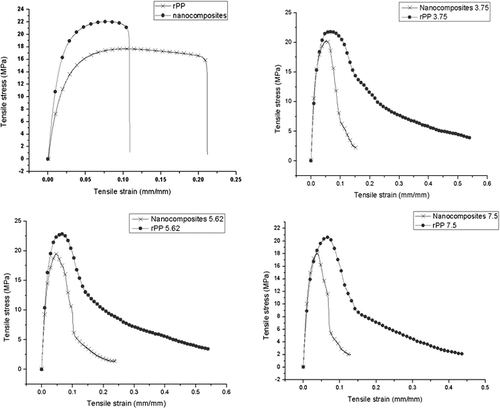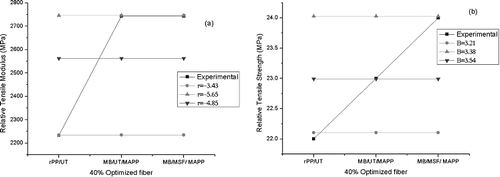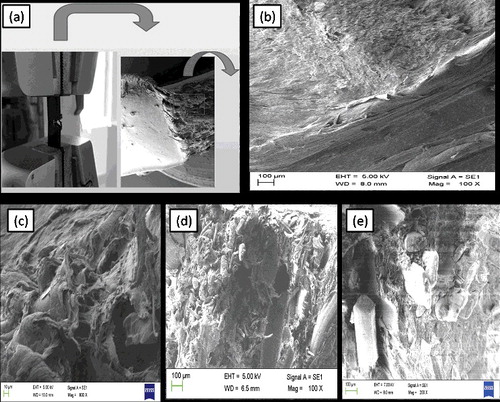ABSTRACT
In the present investigation, recycled polypropylene (rPP) used as a matrix was modified by incorporating nanofillers through melt blending technique to prepare a masterbatch of nanocomposites. Untreated sisal fibre and mercerised sisal fibres were further incorporated into the nanocomposites for the preparation of bionanocomposites. Bionanocomposites containing 40 wt% of UT fibre and 5 wt% of MA-g-PP revealed an increase in the tensile strength and modulus to the tune of 27% and 370%, respectively, compared to rPP. The flexural strength and modulus also increased to the tune of 129% and 269%, respectively, compared to rPP. Further, the surface treatment of the fibre slightly increased the mechanical properties and stiffness of bionanocomposites. Interfacial strength between fibre and matrix was also evaluated by using Turcsanyi and Sato–Furukawa models. Damage tolerance of rPP nanocomposites and its bionanocomposites was evaluated using single-edge-notch specimens. The notch length ‘a’ to width ‘W’ ratios, a/W, were chosen as 0.3, 0.45 and 0.6. The nanocomposites showed better damage tolerance as compared to the rPP matrix. The corrugated structure with increased fractured surface area was observed in scanning electron microscopy. Better dispersion of clay in the nanocomposites was observed in transmission electron microscopy.
1. Introduction
The use of recycled materials, especially in the case of polymers by employing favourable techniques can have both economical and environmental benefits. The problems arising from reusing of recycled materials include structural changes with reduction in molecular weight, decrease in strength, elasticity and viscosity with an increase in melt flow properties that limit its end-use application.[Citation1–3] These changes in properties affect various properties of plastics and its resultant composites. Many researchers [Citation4–6] reported inferior properties: tensile strength and impact strength, in particular, of recycled plastics and their composites compared to their virgin parts which need significant modification with inclusion of fillers, fibres and compatibilisers for attaining desired properties. Najafi et al. [Citation7] and Liang et al. [Citation8] reported lowered stiffness properties of recycled plastics which reduced tensile strength and suspensibility to damage for its composites. In spite of many research works that has been undertaken focusing on reprocessing and recyclability of plastics,[Citation9] only very few research works are available demonstrating the improvement of recycled materials with inclusion of fillers and fibres.[Citation10,Citation11]
Nowadays, inclusion of nanofillers into the polymers provides a new way to overcome the limitations of traditional counterparts. Inclusion of very small amount of nanofillers has the potential to improve mechanical, thermal and life expectancy of material without any substantial increase in the density and cost of formulation.[Citation12–13] Nanoparticles can improve the melt strength in polymer; thus consistency in melt strength can be obtained during the reprocessing of recycled polymer. Nalini et al. [Citation14] reported nanocomposites prepared with 5 wt% of nanoclay and 5 wt% of compatibiliser which showed improvement in mechanical and thermal properties. Touati et al. [Citation10] observed reprocessing cycle modifies the morphology of PP matrix in the presence of nanoclay. Baniasadi et al. [Citation15] reported in situ polymerised nanocomposites showed considerable improvement in tensile yield strength and tensile modulus.
Natural fibres like sisal, banana, pine and coir as a reinforcing member in the thermoplastic matrix have gained considerable popularity in the recent years.[Citation16–17] However, moisture absorption and incompatibility with thermoplastic polymer have been a challenge. Mercerisation of fibre surface results in decreasing of water absorption with increasing in fibre matrix interfacial bonding.[Citation18–19] Sudhakara et al. [Citation20] studied the reinforcing effect of various natural fibres in the polypropylene matrix. Yu et al. [Citation21] studied the effect of chemical treatment on the interfacial bonding and observed an improvement in adhesion properties. Singh et al. [Citation22] reported HDPE matrix reinforced with jute fibre and compatibiliser showed better properties over composite without compatibiliser. Biswal et al. [Citation23] reported that incorporation of fibre in nanocomposites increased the mechanical properties of bionanocomposites. Muhammad et al. [Citation24] investigated the effect of enzymatic-treated Kenaf fibre as a reinforcement for recycled polypropylene (rPP) matrix and shows an improvement in property at 40 wt% loading of fibre.
The philosophy of damage tolerance states that a structure should sustain loads in a damage condition until barely a damage identification is detectable.[Citation25] Damage develops in composites during its manufacturing or service use. The mechanical test which gives the strength and modulus properties of material is not very effective in material selection especially for safe-life design. However, damage tolerance evaluation enables the designer to know the safe mechanical stress for a material in damage condition during its service life. The reliability of composite component is reliant on the integrity of notched/fractured component and the ability to sustain the load. The structural components developed from recycled material, such as decking, fencing, seating, bridges, etc. subjected to various loads, may create fracture/notch in the sample. In this context, the knowledge to damage tolerance is essential.[Citation26,Citation27] Damage tolerance of silicon-matrix-based composite is studied by Liu et al.[Citation28] The author calculated a detectable damage at different testing conditions. It was observed that up to 100 MPa of stress, the values of ‘D’ are almost zero or no damage is detectable. While above the 100 MPa of stress, the specimen tested at −40 °C shows the higher values of ‘D’ compared to specimen tested at −80 °C. Mamiya et al. [Citation29] studied the damage tolerance of woven fabric (Al2O3F–ZrO2)mc/Al2O3 composites. The tensile test specimen was prepared in (90°) fibre axis and (45°) off-axial directions. The detectable damage as observed was about 10 MPa in the case of axial-oriented composites, while 5 MPa for off-axial orientation.
In the present work, the property of rPP has been studied by incorporating cloisite 15A and bio-fibre, sisal. Tensile and impact tests of bionanocomposites were conducted to determine the mechanical properties. The damage tolerance of nanocomposites and its bionanocomposites were evaluated by tensile test method using notched specimen. Three different notched sizes were used to obtain a comparative data on notch depth and damage tolerance. Morphological characterisation and organoclay dispersion were evaluated using a scanning electron microscopy (SEM) and transmission electron microscopy (TEM).
2. Experimental
2.1. Materials
Sisal fibre (agave sisalana) was obtained from M/s Sheeba Fibers and Handicrafts, Poovancode, Tamil Nadu, India. rPP of grade ‘PP108MF10’ (rPP), with MFI 6–7 g/10 min (at 230 °C, 2.16 kg) was obtained from Delhi, India, and was used as a matrix material. Organically modified montmorillonite cloisite (C15A) was used as nanofiller. Chemically, it is a modified clay with hydrogenated tallow (TH), as reported in the product sheet having particle size less than 13 µm and d-spacing of 31.5 Å.
2.2. Surface treatment of sisal fibre
Dried fibre was mercerised in 1 N sodium hydroxyl solution prepared in demineralised water. The fibre was soaked in the basic solution for duration of 18 h. After mercerisation, the fibre was washed with normal water, followed by washing with water containing a few drops of acetic acid.
2.3. Preparation of nanocomposites and its bionanocomposites
Composites were prepared in two stages. In the first step, 3 wt% nanofiller was incorporated into the matrix rPP and nanocomposites were prepared in a batch mixture (Haake Rheocord 9000, M/s Haake, Germany). The batch mixture has a rotor speed of 45 rpm and a mixing time of 12 min. This step provides an opportunity for intercalation or exfoliation of nanofiller in matrix rPP. In the second step, 40 wt% of the short sisal fibre was incorporated into the nanocomposites which was used as matrix and the aforementioned process parameters of rotor speed of 45 rpm and mixing time of 12 min were maintained for the preparation of bionanocomposites. Subsequently, the test specimens were prepared in a micro-injection molding machine (M/s DSM, The Netherlands) at 190 °C, and injection pressure of 90 bar. Finally, the specimens were cooled and conditioned prior to testing for 24 h at 23 ± 5 °C and 55 ± 5 °RH.
2.4. Mechanical tests
Tensile, flexural and impact test of rPP, its nanocomposites and bionanocomposites were studied. The tensile property was calculated using a universal testing machine (UTM, 3382 Instron, UK). The tensile test specimens having dimensions 165 mm × 12.7 mm × 3 mm were tested as per ASTM-D 638. Flexural strength and modulus were determined using the same UTM as per ASTM D 790. The test speed in flexural test was 5 mm/min and the span length of 50 mm. The Izod impact test was performed on an impactometer (Tinius Olsen, USA) as per ASTM D 256.
2.4.1. Theoretical interfacial strength evaluation through micromechanics models
There are some micromechanics models which were suggested to examine the level of adhesion between fibre and matrix. The models which are based on the yield strength are used in this work to evaluate the interfacial adhesion in the bionanocomposites. The tensile strength using Turcsanyi model [Citation30,Citation31] was used for the evaluation of tensile stress of nanocomposites and bionanocomposites:
where σcomp is the tensile strength of bionanocomposites and σ is the tensile strength of rPP and nanocomposites. Similarly, Sato and Furukawa model was used to calculate the theoretical modulus of bionanocomposites [Citation32]:
where Em is young modulus of matrix (i.e. rPP nanocomposites), øf’ the volume fraction of fibre and ζ is an adhesion parameter
2.5. Notched specimen
A single-edge-notch specimen (SEN) of dimensions 63.5 mm × 12.7 mm × 3 mm was used for damage tolerance evaluation. The notch was made on the specimen by using a CEAST Notch cutter (Ceast, Italy). The notch length a to width W ratios, a/W, were chosen as 0.3, 0.45, and 0.6. Tensile test of the notched specimen was carried out at room temperature using the same Universal Testing Machine (3382 Instron, UK) with a constant cross-head displacement rate of 5 mm/min ().
2.6. Damage tolerance evaluation
In this study, damage tolerance was evaluated based on the monotonic tensile test.[Citation29] Damage tolerance () was calculated for the evaluation of damage during the monotonic tensile fracture process as illustrated in
is defined as
where
is the tangent modulus at the ith point in the stress–strain curve (stress
and strain ϵi), and
is the tangent modulus in the linear region of the tensile stress–strain curve.
is inelastic energy absorption at
during the tensile test the change such that
where
is the inelastic portion of the total energy absorption during the tensile test just up to the ultimate tensile strength (UTS)
, such that
where
is the strain at tensile stress
(i.e., strain at fracture).
2.7. Morphological analysis
2.7.1. Scanning electron microscopy (SEM)
The tensile fractured surfaces of the rPP, nanocomposites and their bionanocomposites were taken for morphological study using SEM (EVO MA 15, Carlzeiss SMT, Germany). The samples were gold sputtered (50 nm thickness) and dried for 30 min in a vacuum at 70 °C prior to study.
2.7.2. Transmission electron microscopy (TEM)
The morphology of the nanocomposites was studied by TEM analyser (JEOL, JEM 1400, Japan) operated at an accelerating voltage of 200 kV. Thin sections of about 70–90 nm thickness were microtomed from the tensile test bar using a Lieca ultraceel microtome. The sections were collected from the water on 300 mesh carbon-coated copper grids, for further imaging.
3. Results and discussion
3.1. Effect of nanoclay and sisal fibre on mechanical properties of bionanocomposites
3.1.1. Tensile modulus
The tensile properties of rPP, its nanocomposites and bionanocomposites are depicted in . It is evident from the table that incorporation of organically modified clays revealed an increase in tensile modulus of rPP. The tensile modulus of rPP increased from 583 to 633 MPa in the case of the nanocomposites at 3 wt% of nanoclay loading. This behaviour suggests an improvement in the stiffness of nanocomposites due to deformation resistance imparted by the nanoclay within the oriented polymer backbone.[Citation33] The dispersion of nanoclay in the rPP matrix results in a partially immobilised polymer phase, wherein the silica layers of the clay are oriented along the flow direction, thereby contributing in resistance against the plastic deformation of the polymer backbone within the galleries of clay. Similarly, in the case of bionanocomposites, an additional improvement in the modulus was observed. It can be seen from that bionanocomposites prepared with 40 wt% of sisal fibre and 3 wt% of clay loading showed 333% improvement in tensile modulus as compared with the nanocomposites. This increment in the tensile modulus revealed that sisal fibres are uniformly distributed within the rPP matrix, and effectively transform the stress from fibre to the matrix. However, fibre surface treatment does not show appreciable improvement in tensile modulus of bionanocomposites.
Table 1. Mechanical properties of rPP its nanocomposites and bionanocomposites.
3.1.2. Tensile strength
The tensile properties of rPP, its nanocomposites and bionanocomposites are tabulated in . It can be seen from the table that incorporation of 3 wt% of cloisite 15A with 5 wt% of compatibiliser within the matrix rPP exhibited significant improvement in the tensile strength in the case of nanocomposites. The tensile strength of rPP matrix was 18 MPa which further increased minorly to 22 MPa, probably due to the increase in the degree of dispersion of nanoparticle, and their interaction with the matrix.[Citation34] An increase in the magnitude of the tensile strength of nanocomposites conforms the interaction of nanoclay within the rPP matrix which is possibly due to the presence of compatibiliser ‘MA-g-PP’ that facilitated the expansion of the gallery space of nanolayers by enclosure of polar groups to intercalate between the clay layers through secondary interaction. Similarly, in the case of bionanocomposites, nearly 22% increase in the tensile strength was observed which increased to 28% in the case of untreated sisal-fibre-reinforced bionanocomposites. However, the bionanocomposites prepared using 40 wt% of mercerised sisal exhibited an optimum tensile strength of 24 MPa which is 33% higher than that of rPP. This suggests an improved fibre matrix bonding in the case of mercerised fibre bionanocomposites as compared with untreated fibre. It is also assumed that the increase in tensile properties is primarily due to an efficient stress transfer and an improved compatibility between the mercerised fibres, which allows effective interlocking with the nanocomposite matrix. In addition, anhydride functional group of MA-g-PP forms ester linkage with the hydroxyl group of fibre at the interface. Further, as evident from , the tensile modulus of rPP increased substantially upon reinforcement with fibre and nanoclay.
3.1.3. Flexural strength
The flexural strengths of rPP, nanocomposites and bionanocomposites are also represented in . It is evident from the table that the flexural strength of rPP increased from 27 to 45 MPa in the case of nanocomposites at 3 wt% of clay loading. The increase in flexural strength is attributed to higher aspect ratio of the nanoclay that contributes in effective surface interaction with the increase in flexural properties, which indicates the fact that nanocomposites perform better in bending mode of deformation as compared to rPP. The bionanocomposites reinforced with 40 wt% of sisal fibre and 5 wt% of compatibiliser exhibited additional improvement in flexural strength to the tune of 133% as compared with rPP which additionally confirms the synergistic effect of fibre as well as nanoclay as a reinforcing member in the nanocomposites matrix. Additionally, the test result also reveals that fibre surface mercerisation leads to the fibrillation of the fibres thereby increasing the interfacial adhesion with the rPP which contributes in increasing the flexural strength in bionanocomposites.[Citation13] The tensile and flexural stress–strain curve for rPP, nanocomposites and bionanocomposites is reported in (a)–(b). It is evident from (a) that both matrix rPP and nanocomposites display ductile behaviour under tensile test wherein a plastic deformation up to failure was observed. On the other hand, in the case of bionanocomposites, a decrease in the plastic deformation was noticed, due to the increase in its stiffness. A sharp decrease in elongation was observed, because the fibre restricts the plastic deformation in the system, due to the restricted segmental motion of polymer chain. The surface treatment of fibre does not display a major difference in the tensile stress–strain curve. Similarly, the flexural stress–strain curve showed stiffening effect in both the nanocomposites and its bionanocomposites. Flexural stress–strain curve can be defined in three different regions named linear region, nonlinear region and post-peak curve. It can be seen that linear relationship between flexural stress and strain was observed at a higher stress in bionanocomposites compared to nanocomposites matrix. This behaviour is due to the increase in the stiffness in bionanocomposites. The nonlinear pattern was observed after proportional limit stress (PLS) and is an equivalent stress causing debonding in fibre and matrix bond. Post-peak curve dip in bionanocomposites was also observed possibly because when maximum stress reached some fibre are not broken into two parts, and they still withstand some stress.
3.1.4. Elongation at break
It is evident from that elongation at break (%) is not changed with the incorporation of clay in rPP. In the case of nanocomposites, a decrease in per cent elongation was not appreciable. But in the case of bionanocomposites, a decreased trend in elongation at break was observed. In general, elongation at break is reciprocally related to the stiffness of the material, which changes after incorporation of fibre in the matrix. A surprisingly decrease in elongation at break in bionanocomposites suggests its high stiffness characteristic, probably due to the creation of too many fibre ends, which results in flaws in the composites, and ultimately reduced the plastic deformation of the system.
3.1.5. Impact strength
The impact properties of rPP and its nanocomposites and bionanocomposites are tabulated in . It can be seen from the table that impact strength of rPP in the nanocomposites at 3 wt% of clay loading decreased from 103 to 66 J/m. This behaviour is probably due to stress concentration effect around the nanoparticle, which resulted in the inability to transfer the sudden impact energy from dispersed nanoclay to matrix. Similar observations were also reported by Mahallati et al.,[Citation35] in thermoplastic elastomer nanocomposites. Sah et al. [Citation36] reported that the movement of nanoparticle in the nanocomposites is restricted; hence energy dissipation mechanism is reduced. The nanoparticle in the rPP matrix shows restricted mobility, and initiates crack formation that leads to brittle behaviour. The impact strength of bionanocomposites is also reported in . It is evident from the table that impact strength additionally decreased from 66 to 46 J/m in treated fibre and to 40 J/m in the case of untreated fibre bionanocomposites. This fact can be justified with a similar explanation that incorporation of the fibre creates too many fibre ends in the bionanocomposites, thus resulting in crack initiation and consequent composite failure. Further, marginally higher impact strength in mercerised fibre bionanocomposites can be attributed to better fibre matrix interfacial bonding, wherein fibre fracture occurred with fibre pull-out, therefore, required more energy as compared to fibre delamination.
3.2. Fracture properties
3.2.1. Damage tolerance of rPP and its nanocomposites
Damage tolerance properties of rPP and its nanocomposites for unnotched and notched (a/W of 0.3, 0.45 and 0.6) specimens are reported in (a)–(d). It is evident from (a) that the unnotched rPP matrix shows a detectable damage at a lesser tensile force compared to nanocomposites. Therefore, unnotched rPP shows better damage tolerance as compared to nanocomposites. The lesser values of ‘’ indicate higher damage resistance while, in contrast, higher values of
suggest less damage resistance in a material. However, in the case of notch nanocomposites (a/W of 0.3 and 0.6), there was an improvement in the damage tolerance as compared with rPP matrix. The damage parameter versus tensile stress curve has a lesser magnitude in the case of nanocomposites indicating better damage tolerance of rPP in the presence of nanoclay ((b)–(c) (a/W, 0.3 and 0.45)). Therefore, much higher tensile force is required for a detectable damage in nanocomposite. The rPP with a notch size of 0.6 showed a marginal increase in damage tolerance as compared to its nanocomposites, which is probably due to the increase in the size of notch. The fracture behaviour in nanocomposites indicates an improvement in damage resistance in the notched nanocomposite compared to rPP matrix. This can be attributed to an improvement in matrix properties due to increased interfacial interactions.
Figure 4. Damage tolerance of rPP, its nanocomposites and bionanocomposites sample at single-edge-notch specimen (SEN) of a/W 0.3, 0.45 and 0.6, respectively.
3.2.2. Damage tolerance of nanocomposites and bionanocomposites
The damage tolerance behaviour in the case of nanocomposites and bionanocomposites is reported in (e)–(h). It is evident from the figure that damage tolerance in bionanocomposites is reduced as compared with nanocomposites. Further, the bionanocomposites sample also showed detectable damage at a comparatively lower tensile stress in both notched and unnotched samples. The plastic nature of the nanocomposites was less in the bionanocomposites; therefore, the latter exhibited a relatively stiff and rigid characteristic. Bionanocomposites also exhibited fracture in brittle mode with a very less elongation.
3.2.3. Tensile stress–strain behaviour of unnotched and SEN rPP and its nanocomposites
The tensile stress–strain curve for the unnotched and notched specimens with variable notch depth (a/W, chosen as 0, 0.3, 0.45 and 0.6) is plotted in (a)–(d). It is evident that the unnotched specimen shows fracture by shear yielding; therefore, displaying plastic deformation after yield. However, the presence of a notch in the specimen caused a reduction in the ductility and change in the mode of fracture from shear yielding to crazing. Shear yielding and crazing are the two major modes of deformation in the polymer responsible for ductile and brittle fracture.[Citation37] Arencón et al. [Citation38] reported that unmodified PP generally deforms by shear yielding; however, in some cases crazing is also observed. Shear yielding is a plastic deformation and is generally noticed right after yield, whereas crazing is a process of generation of interpenetrated micro-voids perpendicular to the plane of tensile direction. It is evident from (b)–(d) that the elongation at break is decreased in notched sample due to increases in the stiffness after creating a stress concentration in the sample. Therefore, the notch sample showed fracture by creazing mechanism. Similar observations were also reported by Goolsby et al. that the presence of notch in a specimen increases the stiffness and decreases the ductility.[Citation39] It is also observed that all the samples, i.e. notched rPP as well as the nanocomposites, showed a decrease in ductility with a considerable reduction in the area below stress–strain curve.
3.3. Interfacial interactions between sisal fibre and its matrix (rPP and its nanocomposites)
Sato and Furukawa model is used to evaluate the interfacial strength between fibre and matrix (rPP and nanocomposites) with the help of modulus of composites obtained from experimental results. Similarly, Turcsanyi model is used to evaluate fibre matrix interfacial bonding using tensile strength obtained from the experiment.
3.3.1. Sato and Furukawa model
A comparative interfacial strength between fibre and matrix in the bionanocomposites was studied using Sato and Furukawa model. Three different values of ‘ζ’ were taken to study the comparative fibre matrix interfacial interaction in the bionanocomposites. In our findings, all negative ‘ζ’ values were observed. Furthermore, it was also found that the fibre surface treatment increased the magnitude of the ‘ζ’ values ((a)). The obtained ‘ζ’ value was −4.85 for untreated and −5.65 for mercerised fibre bionanocomposites. The ‘ζ’ value for rPP/ untreated fibre biocomposites has also been reported for comparison. It is evident from (a) that untreated fibre biocomposites showed the least ‘ζ’ value of −3.43, thus indicating a poor interfacial bonding. Sato and Furukawa model showed that the interfacial strength between fibre and matrix increased with fibre mercerisation. A similar investigation on interfacial strength was also reported by Yasser Zare through this model.[Citation40]
3.3.2. Turcsanyi model
Turcsanyi model is used to predict the tensile properties of bionanocomposites and reported in (b). Turcsanyi model parameter ‘B’ value less than 1 indicates poor adhesion at interface, while the value between 1 and 3 indicates some interfacial adhesion between fibre and matrix.[Citation41] Three different values of ‘B’ nearest to the experimental are reported in (b). It was evident from the figure that the bionanocomposites prepared with untreated fibre show the ‘B’ value of 3.38, whereas mercerised fibre shows the B value of 3.54. Therefore, a higher value of fitting parameter suggests better fibre matrix interfacial strength in treated fibre bionanocomposites. However, in the case of rPP/untreated biocomposites, the ‘B’ value was 3.21 which was less than that of the nanocomposites and bionanocomposites; this also shows a lesser interfacial adhesion between the untreated fibre and rPP.
3.4. Morphological analysis
3.4.1. Scanning electron microscopy (SEM) study of rPP, its nanocomposites and bionanocomposites
The SEM of single-edge notch tensile fracture samples consisting of rPP, nanocomposites and bionanocomposites is depicted in (b)–(e). (b) shows the fracture surface of rPP, which revealed a scaly appearance with relatively smooth fracture topography, thus suggesting a brittle fracture. This may be probably because of recycled material, wherein during aging, the length of the polymer chains might have been degraded. In general, short-chain branching is crystallised easily; therefore, crystallinity is increased in rPP which is evident from the brittle fracture in the specimen.[Citation42] The SEM micrograph of nanocomposites has been given in (c). It can be seen from the figure that the presence of clay changes the morphology of the nanocomposites due to changes in the viscosity ratio of the two phases in the system. The fractured morphology of nanocomposites shows corrugated-like fracture structure that resulted in an increase in the surface area during fracture. This is probably due to exfoliation of nanofiller in rPP matrix. The exfoliated silicate nanocomposites increased the stiffness with a reinforcing effect within their rPP matrix.[Citation43] Stiffened behaviour of nanocomposites can also be corroborated from the mechanical findings. However, the fractured surface of bionanocomposites ((d)) shows dispersion of individually separated single fibres, which indicated that the fibre has been separated and dispersed in the matrix during processing. The crack in bionanocomposites was deflected due to the presence of the fibre. The untreated fibre bionanocomposites shows fibre delamination suggesting the fact that the fibre matrix compatibility is not fairly good; also, the fracture surface shows the fibre pull-out which further supports this behaviour. Delamination of fibre from the matrix is an indication of low adhesion between them ((d)). However, in the case of mercerised fibre, bionanocomposites prepared using 40 wt% of fibre with 5 wt% of compatibiliser show broken fibre in the fracture surface, and indicate improved fibre matrix adhesion ((e)).This behaviour is reasonable due to strong frictional stress because of rough fibre surface. The presence of MA-g-PP in the treated fibre bionanocomposites promotes efficient fibre–matrix bond with the formation of an ester linkage at the interface. The probable chemical interaction between nanoclay and sisal fibres (untreated and mercerised) in rPP matrix is shown in . An ester linkage is formed between the OH group of fibre and anhydride group of MAPP. The tallow group of nanoclay also physically interacts via van der Waals force of attraction as shown by a dotted line in
3.4.2. Transmission electron microscopy (TEM) study of nanocomposites
The TEM microstructure for nanocomposites is reported in . It is evident from the figure that the nanolayers were intercalated and well dispersed within the rPP matrix, due to intercalation and exfoliation of nanoclay within the rPP matrix. The lightest dark line in the micrograph represents the dispersed nanoclay layers. Nanoclay is composed of heavier atoms like aluminium, magnesium and silicon; then base matrix which appears darker in the image. The thick dark line represents the agglomeration of nanoclay. Clay agglomerations at the edge of the void may be due to interaction of clay in some places. The exfoliated regions in the nanocomposites is indicated by arrows.
4. Conclusions
In the present work, rPP-matrix-based nanocomposites and its bionanocomposites were successfully prepared using melt blending technique. Sisal fibre was used as a reinforcing filler in bionanocomposites. Tensile modulus, flexural strength and flexural modulus were increased for both the nanocomposites and bionanocomposites. Micromechanics studies suggest better interfacial bonding in mercerised fibre bionanocomposites. Damage tolerance of rPP and its nanocomposites was evaluated in a tensile test. Damage tolerance of the nanocomposites was improved and therefore shows a detectable damage at higher tensile stress in the notched sample (a/W; 0.3 and 0.45). Incorporation of nanoclay is a viable option to improve its fracture properties, and nanocomposites show better damage tolerance properties. However, bionanocomposites showed a reduction in damage tolerance, and showed damage at a comparative less tensile force compared to nanocomposites.
Disclosure statement
No potential conflict of interest was reported by the authors.
References
- Emma S, Karlsson S. The design of a test protocol to model the degradation of polyolefins during recycling and service life. J Appl Polym Sci. 2009;112:1835–1844.
- Francisco V, Karlsson S. Quality concepts for the improved use of recycled polymeric materials: a review. Macromol Mater Eng. 2008;293:274–297.
- Isabelle P, Montrelay N, Bourmaud A, et al. Effect of thermo-mechanical cycles on the physico-chemical properties of poly (lactic acid). Polym Degrad Stab. 2008;93:321–328.
- Walker C, Karlsson S. Assessment of thermal and thermo-oxidative stability of multi-extruded recycled PP, HDPE and a blend thereof. Polym Degrad Stab. 2002;78:385–391.
- Li TQ, Ng CN, Li. RKY. Impact behavior of sawdust/recycled–PP composites. J Appl Polym Sci. 2001;81:1420–1428.
- Gregorová A, Cibulková Z, Košíková B, et al. Stabilization effect of lignin in polypropylene and recycled polypropylene. Polym Degrad Stab. 2005;89:553–558.
- Kazemi-Najafi S, Mostafazadeh-Marznaki M, Tajvidi M, et al. Effect of thermo-mechanical degradation of polypropylene on mechanical properties of wood polypropylene composites. J Compos Mater. 2009;43:2543–2554.
- Liang G, Xu J, Bao S, et al. Polyethylene/maleic anhydride grafted polyethylene/organic-montmorillonite nanocomposites. I. Preparation, microstructure, and mechanical properties. J Appl Polym Sci. 2004;91:3974–3980.
- Bertini F, Canetti M, Audisio G, et al. Characterization and thermal degradation of polypropylene–montmorillonite nanocomposites. Polym Degrad Stab. 2006:91:600–605.
- Touati N, Kaci M, Bruzaud S, et al. The effects of reprocessing cycles on the structure and properties of isotactic polypropylene/cloisite 15A nanocomposites. Polym Degrad Stab. 2011;96:1064–1073.
- Mohammad Amin D, Ziaei Hassan T, Hosseinpourpia R, et al. Investigation of the morphological and thermal properties of waste newsprint/recycled polypropylene/nanoclay composite. BioResources. 2012;7:0936–0945.
- Lau K, Cheung KH, Hui D. Natural fiber composites. Compos B. 2009;40:591–593.
- Mohanty S, Verma SK, Nayak SK, et al. Influence of fiber treatment on the performance of sisal-polypropylene composites. J Appl Polym Sci. 2004;94:1336–1345.
- Nalini R, Nagarajan S, Reddy BSR. Polypropylene-blended organoclay nanocomposites – preparation, characterisation and properties. J Exp Nanosci. 2013;8:480–492.
- Baniasadi H, A. Ramazani SA, Javan Nikkhah S. Investigation of in situ prepared polypropylene/clay nanocomposites properties and comparing to melt blending method. Mater Des. 2010;31:76–84.
- Kumar KP, Sekaran ASJ. Some natural fibers used in polymer composites and their extraction processes: a review. J Reinf Plast Compos. 2014;33:1879–1892.
- Quynh Truong Hoang T, Lagattu F, Brillaud J. Natural fiber-reinforced recycled polypropylene: microstructural and mechanical properties. J Reinf Plast Compos. 2008;29:209–217.
- Nayak S, Dixit G, Sisal fiber AKK. (SF) reinforced recycled polypropylene (RPP) composites. Int J Plast Technol. 2012;16:150–165.
- Kondo 1Y, Miyazaki K, Takayanagi K, et al. Surface treatment of PET fiber by EB-irradiation-induced graft polymerization and its effect on adhesion in natural rubber matrix. Eur Polym J. 2008;44:1567–1576.
- Sudhakara P, Jagadeesh D, Wang Y, et al. Fabrication of borassus fruit lignocellulose fiber/PP composites and comparison with jute, sisal and coir fibers. Carbohydr Polym. 2013;98:1002–1010.
- Yu T, Wu C, Wang C, et al. Effects of surface modi fi cations on the interfacial bonding of fl ax/β-polypropylene composites. Compos Interfaces. 2013;20:483–496.
- Singh AA, Palsule S. Jute fiber-reinforced chemically functionalized high density polyethylene (JF/CF-HDPE) composites with in situ fiber/matrix interfacial adhesion by Palsule process. Compos Interfaces. 2013;20:553–573.
- Biswal M, Mohanty S, Nayak SK. Mechanical, thermal and dynamic-mechanical behavior of banana fiber reinforced polypropylene nanocomposites. Polym Compos. 2011;32:1190–1201.
- Muhammad R. Islam AG, Beg MDH. Raw. characterization of laccase-treated kenaf fibre reinforced recycled polypropylene composites. BioResources. 2013;8:3753–3770.
- Sierakowski RL, Newaz GM. Damage tolerance in advanced composites. Boca Raton (FL): CRC Press; 1995.
- Bajracharya RM, Manalo AC, Karunasena W, et al. An overview of mechanical properties and durability of glass-fibre reinforced recycled mixed plastic waste composites. Mater Des. 2014;62:98–112.
- Hussain F. Review article: polymer–matrix nanocomposites, processing, manufacturing, and application: an overview. J Compos Mater. 2006;40:1511–1575.
- Liu X, Cheng L, Zhang L, et al. Tensile properties and damage evolution in a 3D C/SiC composite at cryogenic temperatures. Mater Sci Eng A. 2011;528:7524–7528.
- Mamiya T, Kakisawa H, Liu WH, et al. Tensile damage evolution and notch sensitivity of Al2O3 fiber–ZrO 2 matrix minicomposite-reinforced Al2O3 matrix composites. Mater Sci Eng. 2002;325:405–413.
- Pukánszky B. Influence of interface interaction on the ultimate tensile properties of polymer composites. Composites. 1990;21:255–262.
- Turcsányi B, Pukánszky B, Tüdõs F. Composition dependence of tensile yield stress in filled polymers. J Mater Sci Lett. 1988;7:160–162.
- Sato Y, Furukawa J. A molecular theory of filler reinforcement based upon the conception of internal deformation (a rough approximation of the internal deformation). Rubber Chem Technol. 1963;36:1081–1106.
- Lin Y, Chen H, Chan C, et al. High impact toughness polypropylene/CaCO3 nanocomposites and the toughening mechanism. Macromolecules. 2008;41:9204–9213.
- Tri Phuong N, Gilbert V, Chuong B. Preparation of recycled polypropylene/ organophilic modified layered silicates nanocomposites part I: the recycling process of polypropylene and the mechanical properties of recycled polypropylene/organoclay nanocomposites. J Reinf Plast Compos. 2008;27:1983–2000.
- Mahallati P, Arefazar A, Naderi G. Thermoplastic elastomer nanocomposites based on PA6/NBR. Int Polym Proc. 2010;25:132–138.
- Shah D, Maiti P, Jiang DD, et al. Effect of nanoparticle mobility on toughness of polymer nanocomposites. Adv Mater. 2005;17:525–528.
- Narisawa I. Crazing and shear yielding in polypropylene. In: Karger-Kocsis J, editor. Polypropylene SE-17. Dordrecht: Kluwer publishers. 1999. p. 124–127.
- Arencón D, Velasco JI. Fracture toughness of polypropylene-based particulate composites. Materials. 2009;2:2046–2094.
- Goolsby RD, Chatterjee AM. Notch sensitivity and fractography of polyoletins. Polym Eng Sci. 1983;23:117–124.
- Zare Y. Determination of polymer–nanoparticles interfacial adhesion and its role in shape memory behavior of shape memory polymer nanocomposites. Int J Adhes. 2014;54:67–71.
- Liang J-Z. Reinforcement and quantitative description of inorganic particulate-filled polymer composites. Compos Part B. 2013;51:224–232.
- Adhikary KB, Pang S, MP S. Accelerated ultraviolet weathering of recycled polypropylene sawdust composites. J Thermoplast Compos Mater. 2009;22:661–679.
- Sinha Ray S, Okamoto M. Polymer/layered silicate nanocomposites: a review from preparation to processing. Prog Polym Sci. 2003;28:1539–1641.

